Finches are drawn to Nyjer seed feeders due to the seeds' exceptional nutritional profile – they're packed with 39% fat and 19% protein, providing essential energy for these small birds. The seeds' tiny size perfectly matches finches' compact beaks, making them easy to consume. Special tube or mesh feeders with small ports prevent wastage while allowing finches to feed in their natural clinging position. You'll discover even more ways to attract these colorful visitors when you explore proper feeder setup and maintenance.
The Nutritional Powerhouse: High Energy Content of Nyjer Seeds
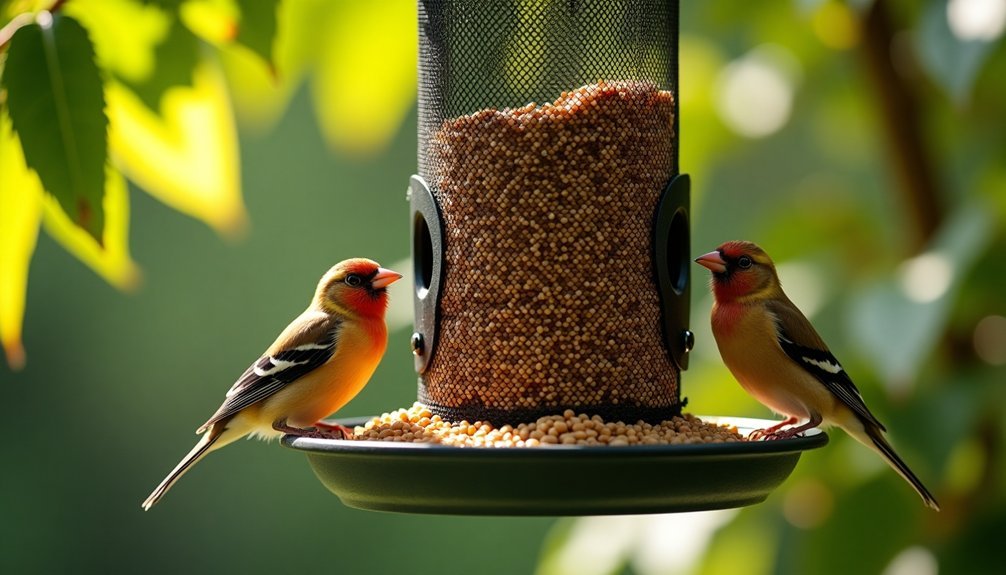
While many backyard birders know Nyjer seed attracts finches, few realize they're offering a nutritional powerhouse. At 512 calories per 100 grams, these tiny black seeds deliver concentrated energy that's especially essential during cold weather when birds need extra fuel.
You're providing nearly 39% fat content when you fill your feeders with Nyjer, primarily in the form of essential fatty acids that support healthy plumage and metabolism. These seeds are particularly valuable because they contain an exceptional amount of poly unsaturated fatty acids, which make up the majority of their fat profile.
The impressive 19% protein content helps your finches maintain muscle and aids in feather regrowth during molting periods.
Beyond fats and proteins, you're also supplying significant B vitamins and minerals like calcium, iron, and zinc—all without cholesterol.
This nutritional efficiency explains why finches spend hours at Nyjer feeders, especially in winter when survival depends on finding high-quality food sources.
Finch Species Attracted to Nyjer Seed Feeders
Goldfinches create a flutter of golden activity at Nyjer feeders, but they're just the beginning of the finch diversity you'll attract.
House finches regularly visit these specialized feeders, appreciating how the tiny ports perfectly accommodate their feeding style.
You'll also spot purple finches seeking the oil-rich seeds that provide essential energy, especially during colder months.
Pine siskins, though smaller than their finch relatives, enthusiastically gather at well-stocked Nyjer feeders for nutritional benefits.
With patience, you might even entice indigo buntings, which occasionally join the finch feeding frenzy.
Each species brings its unique colors and behaviors to your yard.
The Squirrel Buster® Finch feeder features 8 feeding ports specifically designed to accommodate multiple finches feeding simultaneously.
The Perfect Feeder Design for Nyjer Seeds
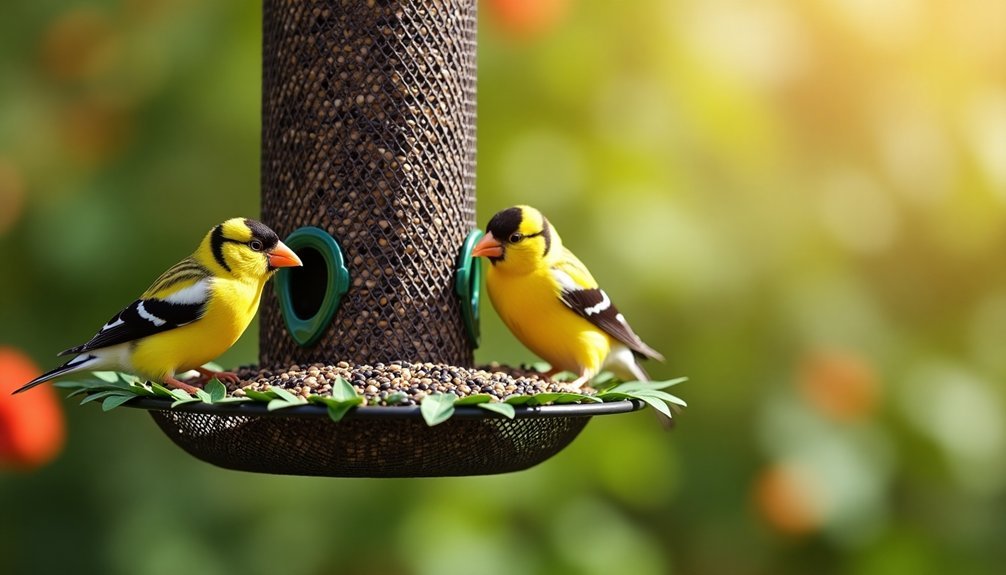
When choosing a feeder for Nyjer seeds, you'll find that tube feeders offer remarkable efficiency with their small ports that prevent wasteful spillage.
Mesh designs provide an advantage by allowing finches to cling naturally while feeding from multiple positions around the feeder.
You'll want to look for feeders with tight-fitting components and weather guards that keep seeds dry and minimize the loss of these tiny, expensive seeds. Since these seeds are primarily oil crops imported from India and Ethiopia, their cost makes proper feeder design especially important.
Tube Feeder Efficiency
The ideal nyjer seed feeder combines thoughtful design with practical functionality to serve finches effectively.
Tube feeders excel in this role by protecting the tiny seeds from moisture that can cause mold while storing enough seed to reduce your refill frequency.
You'll appreciate how easy tube feeders are to install—simply hang them from a line or shepherd's hook.
Their specialized design features small port holes that accommodate finches' feeding habits while excluding larger birds. This creates a dedicated dining space for your finch visitors.
Even chickadees can utilize these mesh or tube feeders successfully due to their excellent hanging ability when feeding.
For best results, clean your feeder regularly to prevent disease transmission among birds.
Consider adding weather guards during rainy periods and use products like Feeder Fresh to absorb excess moisture.
These simple maintenance steps guarantee your finches enjoy fresh, healthy nyjer seeds year-round.
Mesh Design Advantages
While tube feeders offer excellent protection for nyjer seeds, mesh designs represent another outstanding option for attracting finches to your yard. You'll notice the tiny openings perfectly match nyjer seed size, preventing larger birds from accessing the feast while giving finches comfortable feeding access.
- Mesh allows finches to cling and perch comfortably while feeding
- Superior ventilation keeps seeds drier, reducing mold and spoilage
- Clear visibility enhances your birdwatching experience
- Easy-to-clean designs with quick-release bases simplify maintenance
- Weather-resistant materials guarantee durability year-round
The stainless steel construction of quality mesh feeders provides longevity while remaining lightweight.
You'll appreciate how quickly these feeders dry after rain, keeping seeds fresher longer. For maximum success, place your mesh feeder in a quiet area near protective cover. These feeders are particularly attractive to goldfinches because of the high protein content in nyjer seeds that supports their dietary needs.
Preventing Seed Spillage
Four key design features make the perfect nyjer seed feeder exceptionally spillage-resistant. Tube feeders with narrow feeding ports allow finches to extract seeds precisely without scattering them. Built-in seed trays catch any dropped seeds, giving birds a chance to consume them rather than losing them to the ground. Mesh or sock feeders are also excellent options for serving nyjer seed with minimal waste.
When selecting your feeder, look for anti-spill features and easy-to-remove parts for cleaning. Secure your feeder properly to prevent unwanted movement that causes spillage. You'll also want to fill feeders quickly rather than slowly pouring, which greatly reduces waste.
For ideal placement, choose locations sheltered from wind and position feeders away from each other to prevent overcrowding.
These simple strategies will keep your nyjer seeds where they belong—in your feeders and in the beaks of hungry finches.
Seasonal Feeding Patterns of Finches
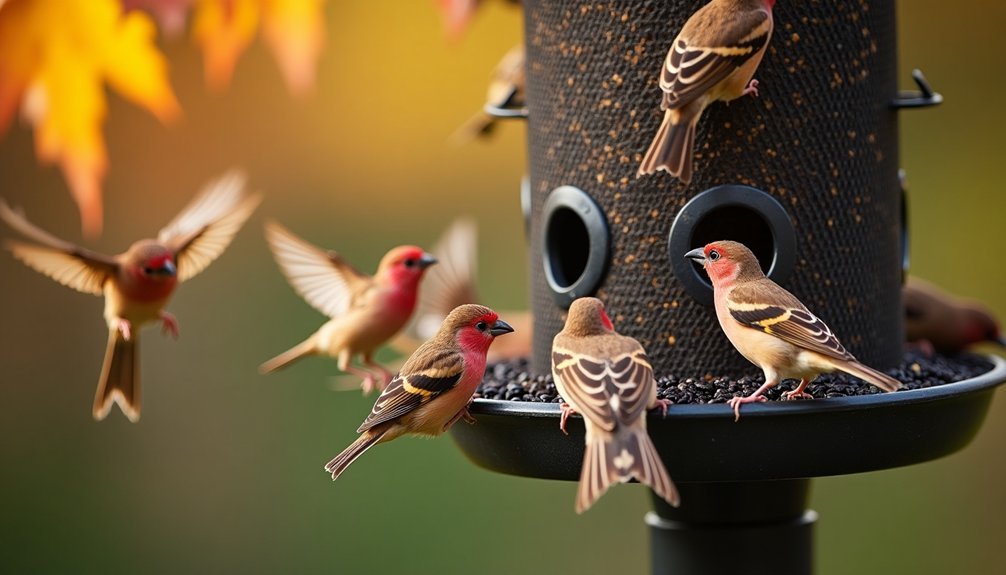
You'll notice a remarkable surge in finch activity at your Nyjer feeders during winter months when natural food sources become scarce.
This increased feeder dependence contrasts with spring and summer, when finches balance feeder visits with foraging for abundant natural seeds, buds, and flowers. This feeding pattern mirrors the natural austerity diet approach that wild birds experience, where food availability fluctuates with the seasons.
Winter Feeding Surge
As winter's grip tightens across North America, finch activity at backyard feeders often surges dramatically, especially when boreal forest food sources become depleted.
You'll notice Pine Siskins and Redpolls appearing when cone crops fail, with their movements carefully tracked by the Finch Research Network.
During these cold months, your feeders become essential energy stations for these nomadic birds:
- Nyjer seed, with its high oil content, becomes particularly attractive as finches seek calorie-dense food
- Tube or hopper feeders filled with sunflower seeds draw in Pine Grosbeaks and Evening Grosbeaks
- Expect more frequent refilling needs as hungry flocks descend
- Poor Mountain Ash berry and Alder crops up north directly influence which species you'll see
- Supplementing with suet provides additional energy critical for winter survival
American goldfinches and other finch species rely heavily on Niger seed as their preferred winter food source.
Natural Food Alternatives
While commercial Nyjer seed remains a finch favorite, nature provides a rich array of alternatives that mirror these birds' seasonal foraging habits.
During spring, you'll notice finches gravitating toward fresh greens like dandelions and kale, which support their breeding activities.
Summer brings molting season, when they'll need more balanced nutrition from pellets and fresh produce to maintain healthy plumage.
As autumn approaches, finches prepare for winter by seeking higher-fat options like sunflower seeds.
You can supplement their diet year-round with millet varieties, canary grass seed, and flaxseed—all providing essential nutrients while mimicking natural foraging patterns. Quality finch blends containing Japanese millet and canola seed offer a holistic approach to finch nutrition.
For protein boosts during breeding, offer live mealworms or boiled eggs.
Remember that regional availability will influence which alternatives work best in your backyard feeding station.
How to Maintain Fresh Nyjer Seeds for Maximum Attraction
Fresh Nyjer seeds stand as the cornerstone of successful finch attraction, with their quality directly influencing how many colorful visitors your feeders will receive.
Quality Nyjer seeds aren't just bird food—they're your invitation to a vibrant finch gathering.
Store your seeds in airtight containers in cool, dry locations to preserve their nutritional value and appealing taste. The high oil content of Nyjer seeds makes them particularly susceptible to rancidity when improperly stored.
- Keep seeds below 80°F and away from direct sunlight to prevent deterioration
- Freeze seeds in sealed containers for long-term storage (can last years versus months)
- Check regularly for mold, clumping, or rancid smells—all signs it's time for replacement
- Pinch seeds between your nails—fresh ones should produce oil
- Rotate your stock, using oldest seeds first to minimize waste
The Natural Foraging Behavior of Finches
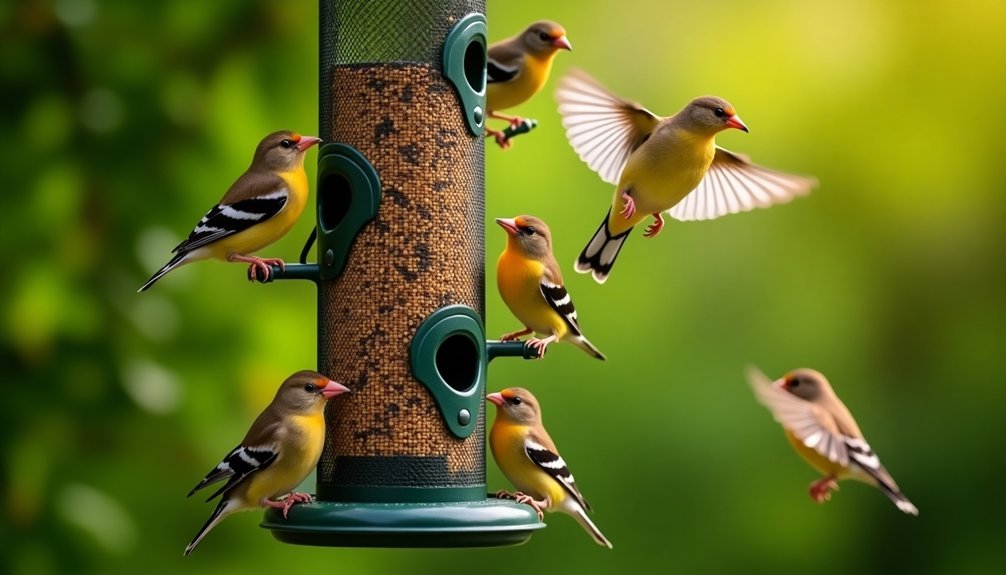
Understanding how finches behave in the wild can dramatically improve your feeding strategy. These adaptable birds naturally seek out seeds high in oil content, which explains their attraction to nyjer.
In nature, finches forage in flocks, establishing dominance hierarchies that determine access to prime feeding spots. You'll notice finches use their specialized beaks to efficiently extract seeds from grasses and plants. Nyjer® seed's high oil content makes it an especially valuable energy source during winter months when birds need extra calories.
They're opportunistic feeders, adjusting their diets seasonally and after rainfall when seed availability changes. While primarily seed-eaters, many species supplement with fruits, insects, and occasionally nectar.
Finches typically establish feeding grounds near their nesting sites in deciduous or coniferous trees. They're highly responsive to environmental changes, synchronizing their movements between feeding locations and communicating through songs and visual displays while foraging.
Nyjer Seeds vs. Other Bird Seed Options
Nyjer seeds outperform most bird seed options with their exceptionally high oil content, providing finches with superior energy for their active lifestyles.
You'll find their selective appeal particularly valuable when you want to attract specific finch species like American Goldfinches and Purple Finches without drawing in larger bird competitors.
While they're more expensive than sunflower or safflower seeds, their specialized nutritional profile makes them worth the investment if finches are your target visitors. It's best to introduce nyjer seed when goldfinches are already visiting your garden to increase the likelihood of success.
Nutritional Value Comparison
When comparing bird seed options, Nyjer seeds stand out as nutritional powerhouses for finches and other small birds. With 16-20% protein and 25-35% fat content, they provide the perfect balance of nutrients that finches need for their active lifestyles, especially during winter months and breeding seasons.
Unlike larger options like cracked corn or black oil sunflower seeds, Nyjer's small size perfectly matches finches' compact beaks.
You'll notice your backyard visitors prefer these seeds for their:
- Higher oil content than many alternatives, providing essential fatty acids for healthy plumage
- Exceptional energy-to-size ratio compared to millet or mixed blends
- Superior freshness when properly stored, which finches can detect
- Cleaner yard experience as they won't sprout weeds like some alternatives
- Better nutritional balance than suet alone for year-round feeding
These tiny seeds are particularly valuable during molting season when birds require additional nutrition to support energy demands while replacing their feathers.
Selective Appeal Benefits
The selective appeal of Nyjer seed creates a win-win scenario for both finches and birdwatchers alike. These specialized feeders are designed with small openings that only accommodate the tiny beaks of finches while excluding larger birds and squirrels. Finches are particularly drawn to Nyjer seeds because of their higher oil content compared to thistle seeds.
| Nyjer Seed Benefits | Why It Matters |
|---|---|
| Small openings | Only finch-accessible |
| High oil content | Extra energy in cold weather |
| No shell waste | Less cleanup under feeders |
| Squirrel avoidance | Reduced competition |
| Heat sterilization | Won't germinate in your garden |
You'll enjoy consistent finch activity throughout the year while minimizing maintenance. Unlike thistle seeds, Nyjer doesn't create shell waste beneath your feeders. The seed's high calorie and protein content provides essential nutrition for your finch visitors, making your feeder their preferred dining spot.
Creating a Finch-Friendly Urban Garden
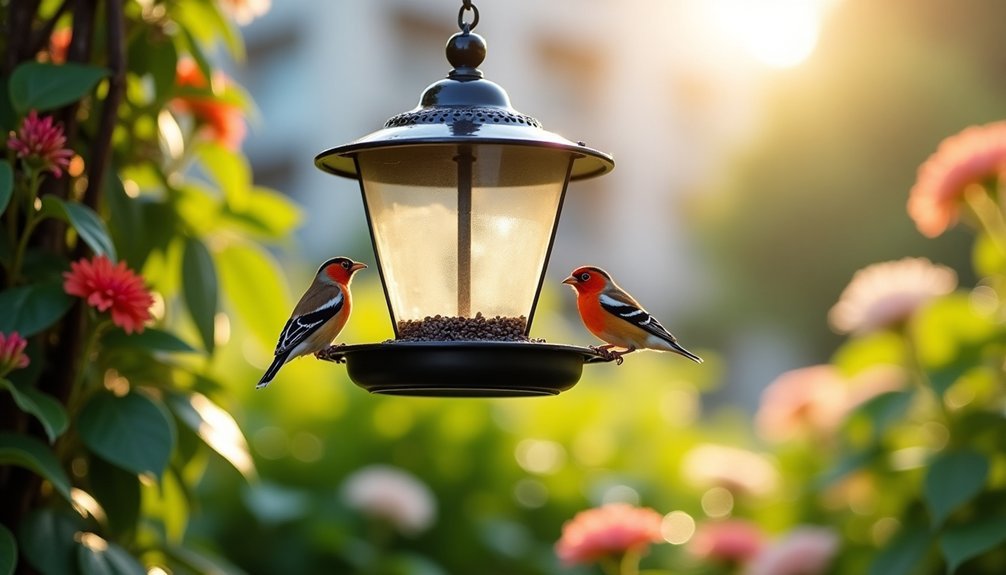
Transforming your urban space into a finch sanctuary doesn't require vast areas of land, but rather thoughtful planning and strategic plant selection.
Creating an urban finch haven requires only thoughtful design and strategic planting, not expansive territory.
Incorporate native seed-bearing plants like coneflowers, thistles, and black-eyed Susans that finches naturally gravitate toward. Design your garden with both open spaces and dense screening vegetation to provide feeding areas and protective cover. Remember to avoid invasive thistle varieties and instead choose native thistle species that won't overtake your garden.
- Place nyjer seed tube or sock feeders near sheltering shrubs where finches feel protected
- Include a small water feature with moving water to attract finches year-round
- Leave seed heads intact during fall and winter as natural food sources
- Create meandering paths that enhance garden depth while allowing observation points
- Combine finch-friendly plants with pollinator species for a complete ecosystem that supports diverse wildlife
Observing and Identifying Finches at Your Feeder
Successful finch gardens naturally lead to the rewarding experience of watching these colorful visitors at your feeders. Learning to identify different finch species enhances this pleasure and helps you tailor your feeding strategy.
| Species | Male Identification | Female Identification |
|---|---|---|
| House Finch | Red to orange forehead with brown cheek patches | Brown-grey with sparrow-like streaks |
| Purple Finch | Reddish color on cheeks, back, and wings | Similar to female House Finch but with a bolder eye stripe |
| Cassin's Finch | Bright red crown and whitish eye rings | Streaked appearance with subtle facial markings |
| American Goldfinch | Bright yellow with black wings (breeding) | Duller olive-yellow coloration |
| Evening Grosbeak | Yellow with black wings and large beak | Grey-brown with hints of yellow |
You'll notice finches tend to cling vertically while feeding, unlike ground-feeding birds. Their conical beaks work perfectly to crack open the tiny Nyjer seeds. For accurate identification, pay attention to the distinctive facial markings of female finches, which are often the key to distinguishing between similar species.
Troubleshooting Common Issues With Nyjer Seed Feeders
Despite your best efforts to create an inviting finch habitat, you may encounter several challenges with your Nyjer seed feeders. Most issues stem from seed freshness, moisture problems, or feeder placement.
Even the most carefully planned finch sanctuaries face hurdles with Nyjer feeders, typically related to seed quality, moisture control, or location.
If finches aren't visiting your feeders as expected, consider these common solutions:
- Store Nyjer seed at room temperature to preserve its oil content and nutritional appeal
- Clean feeders regularly with vinegar or bleach solution to prevent mold buildup
- Install weather guards to keep seed dry during rainy periods
- Replace seed every 1-2 months, as older seed loses its attractive oils
- Position feeders near natural cover but away from areas where seed husks accumulate
When troubleshooting, remember that seasonal changes in native plant availability may temporarily reduce feeder visits, regardless of your setup's quality. Inspect seeds before purchase, ensuring they appear shiny black rather than dull or brown, which indicates higher oil content that attracts finches.
Frequently Asked Questions
Why Do Finches Sometimes Ignore Nyjer Seed Feeders Altogether?
Finches ignore nyjer feeders when the seed is stale, dried out, or overheated during processing. You'll need to replace old seed, use proper tube feeders, and make certain it doesn't get wet or clumpy.
Do Nyjer Seeds Cause Unwanted Plant Growth Under Feeders?
No, properly sterilized nyjer seeds won't cause unwanted growth under your feeders. They're heat-treated at 248°F for 15 minutes as required by the USDA to prevent germination, eliminating any sprouting concerns.
How Do Wind and Weather Affect Nyjer Seed Consumption?
Wind can scatter Nyjer seeds, reducing consumption. You'll find rain or snow causes seed spoilage and mold. Keep your feeders ventilated and clean, as wet conditions make seeds less accessible to birds.
Are There Any Birds Besides Finches Attracted to Nyjer?
Yes, you'll find redpolls, pine siskins, chickadees, towhees, and doves visiting your nyjer feeders. While finches are the primary visitors, these other birds will happily enjoy the high-energy seeds too.
What's the Environmental Impact of Importing Nyjer Seeds Globally?
You're contributing to carbon emissions through long-distance shipping when you buy imported nyjer. These imports also risk introducing invasive species like dodder, despite heat sterilization regulations designed to protect native ecosystems from contamination.
In Summary
By providing Nyjer seed feeders, you're offering finches their preferred high-energy food source in an ideal delivery system. You'll attract goldfinches, house finches, and other colorful species throughout the year, especially during migration and breeding seasons. Keep your seeds fresh, choose the right feeder design, and you'll create a finch haven in your garden. It's a rewarding way to enjoy these beautiful, energetic visitors up close.

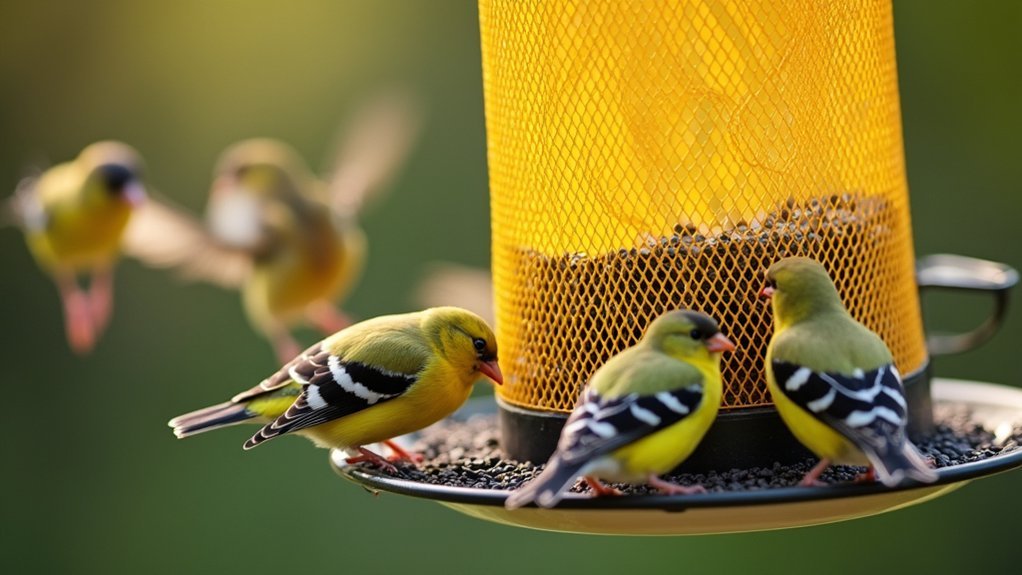



Leave a Reply